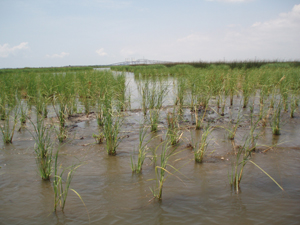 More than 2,500 acres of coastal wetlands have been restored and enhanced in Port Arthur, Texas, as a result of a cooperative agreement between Chevron, the polluter, and federal and state natural resource agencies. The clean-up efforts not only provide beneficial habitats for the fish and wildlife of the area, but also will expand outdoor recreation areas for the public.
More than 2,500 acres of coastal wetlands have been restored and enhanced in Port Arthur, Texas, as a result of a cooperative agreement between Chevron, the polluter, and federal and state natural resource agencies. The clean-up efforts not only provide beneficial habitats for the fish and wildlife of the area, but also will expand outdoor recreation areas for the public.
Chevron Corporation was forced to restore the habitats after toxic releases from its refinery operations decades ago. They cooperated with the National Oceanic and Atmospheric Administration (NOAA), the U.S. Fish and Wildlife Service, Texas Commission on Environmental Quality, Texas Parks and Wildlife Department, and the Texas General Land Office to fund the 4 square miles (1000 hectares) of restoration.
Healthy coastal wetlands are particularly valuable in providing a buffer as tropical storms and hurricanes move onshore.
The largest restoration occurred in the Lower Neches Wildlife Management Area near the Gulf of Mexico, where a project restored historic water flow conditions to approximately 1,300 acres of coastal wetlands. Nearly 90 acres of estuarine intertidal marsh and more than 30 acres of coastal wet prairie were also created.
Approximately 1,500 acres of coastal emergent marsh plant communities have been restored to historical conditions through the installation of berms and other water control structures.
The original operations at Clark Chevron refinery in Port Arthur, which has been in operation since 1902, were responsible for the release of hazardous substances related to its production of gasoline, kerosene, jet fuel and petrochemicals.
The natural resource trustees worked with Chevron to assess the injuries to the environment. Once the amount of restoration needed was agreed upon, Chevron implemented the compensatory restoration projects with trustee oversight beginning in 2007.
As a principal trustee for the public’s coastal natural resources, NOAA’s Damage Assessment, Remediation and Restoration Program, restores habitats and communities that have been harmed by oil spills, hazardous substance releases and ship groundings. Through the program, NOAA works with other agencies, industry, and communities to protect and restore these coastal and marine resources.
Since its inception in 1992, the program has successfully protected natural resources at more than 500 waste sites. As of 2008, the program had settled almost 200 natural resource damage assessment cases, generating almost $450 million for restoration projects.
NOAA assesses and predicts changes in the Earth’s environment,”from the depths of the ocean to the surface of the sun,” and conserves and manages US coastal and marine resources.
(from a NOAA press release)



















